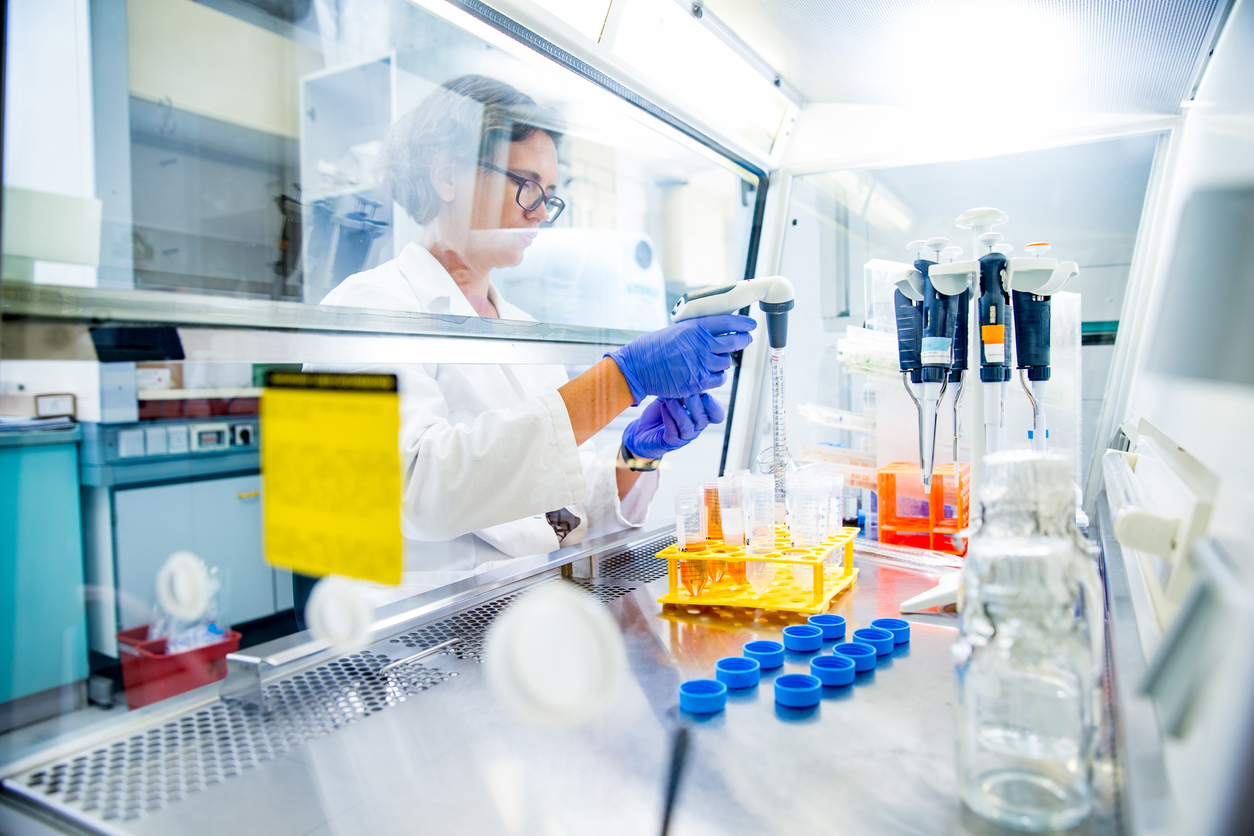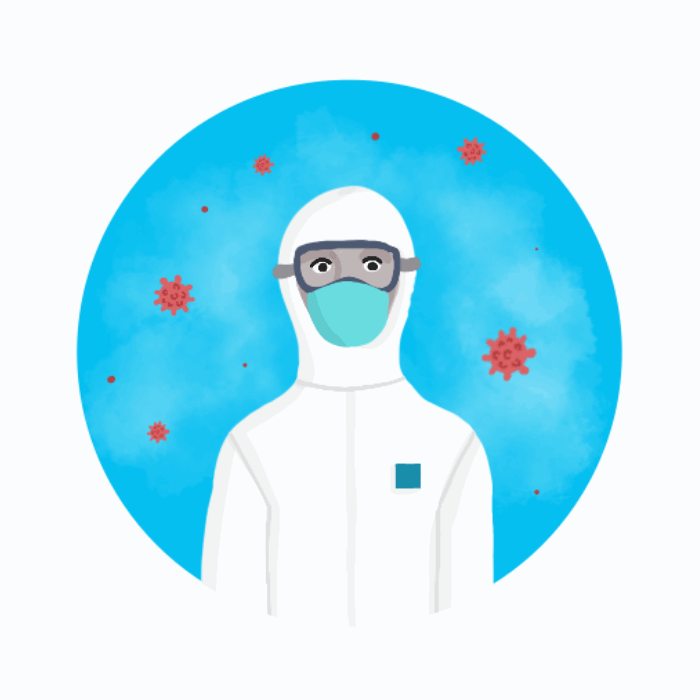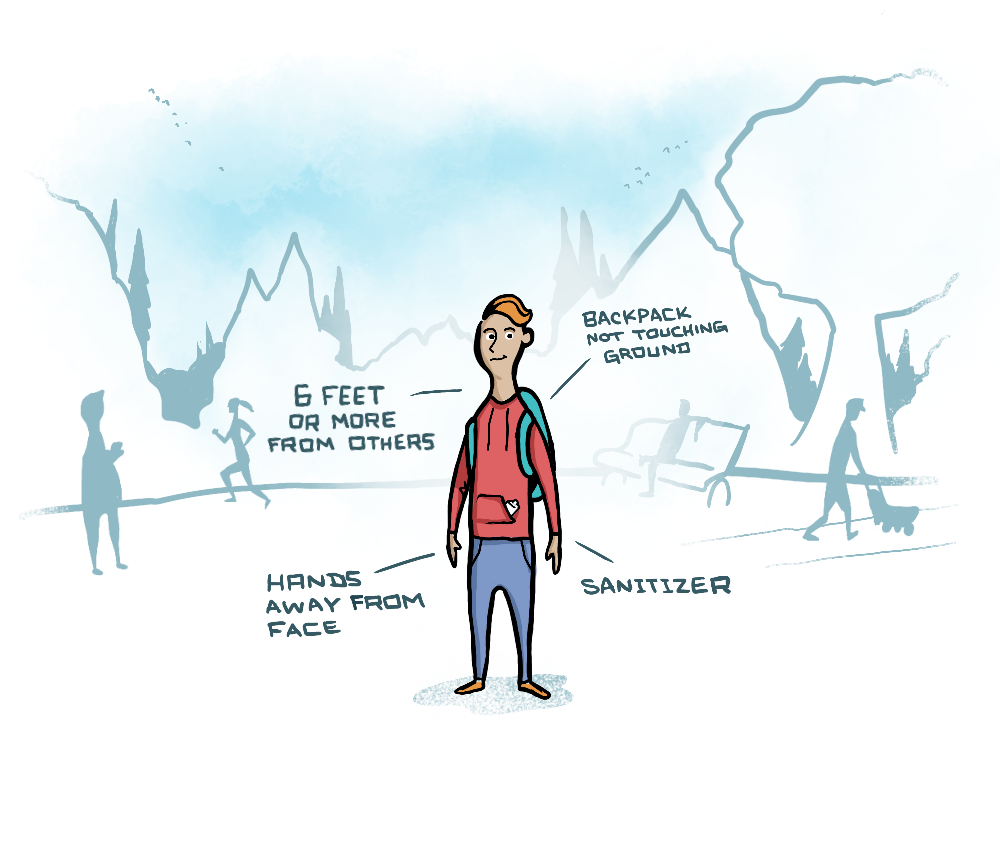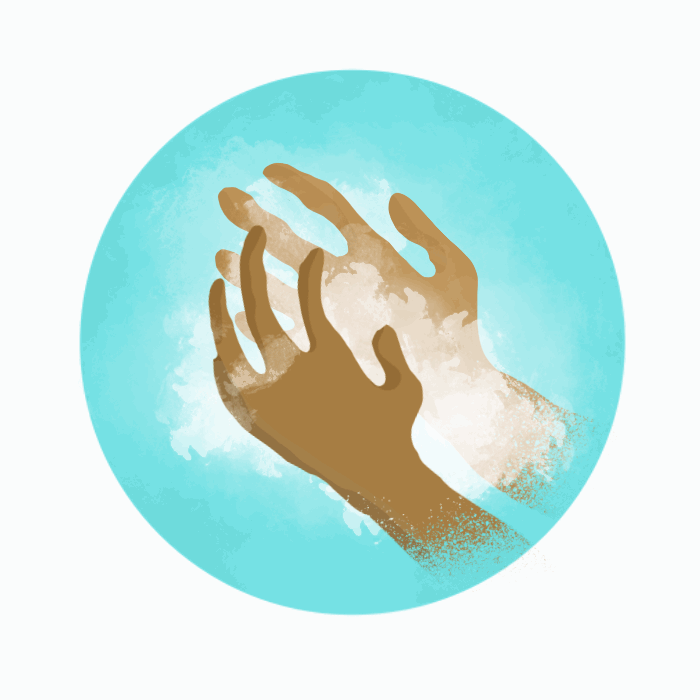Special thanks to Dr. Teresa Wolfe, program chair of the Medical Laboratory Technician program at Portland Community College, for help with this blog post.
Have you ever seen pictures or movie scenes of a scientist working in a lab wearing gloves, glasses and a lab coat, or even a protective face shield or full body pressurized suit, working with some equipment or tubes within a metal and glass case (a biosafety cabinet)? If you have, then you’ve seen firsthand how scientists keep potentially dangerous things that they are working with (including microbes and viruses) inside the lab.


Scientists can work with very dangerous infectious agents, including viruses like ebola, in lab environments. In the lab, scientists take many precautions to make sure that viruses and other infectious agents don’t get into their bodies or out of the lab.
Different infectious agents require different levels of lab safety, or biosafety levels (BSL). Scientists can only work with Ebola in BSL-4 (the highest level) labs, wearing pressurized suits. What about the novel coronavirus? Scientists can work with and study this virus in BSL-3 and BSL-2 labs, depending on what they are doing with the virus. They are sometimes wearing only gloves, face shields and lab coats, other times wearing a respirator.
So how do scientists working with the novel coronavirus or other infectious agents in a lab keep those pathogens from getting into their bodies or out of the lab and into the world? It’s not just by wearing gloves or covering their faces – this only protects them while they are actively handling something with an infectious agent in it. They follow all kinds of other practices and procedures that keep the infectious agent only where it is supposed to be.
But you don’t need to have a BSL-2 lab to keep the inside of your body free from the novel coronavirus or to prevent spreading it to others. You can learn from tried and true practices and precautions that scientists use in the lab working with viruses like the novel coronavirus!
Here are 10 things you can in your daily life to prevent the spread of infection:

Ways to protect yourself and others from coronavirus infection while in public spaces. Illustration by Doryan Algarra.
1. Wipe down, avoid touching or wash your hands after coming into contact with “high-touch” objects in public spaces.
Scientists call these “fomites”, which are “objects or materials which are likely to carry infection”. In the lab, scientists regularly wipe down and sanitize (with a mixture of water and ethyl alcohol, a mixture of bleach and water, or a Lysol solution) high-touch zones like refrigerator handles (yes, scientists keep samples in refrigerators!), microscope handles and eyepieces, lab cabinet handles, door knobs, pipette handles, pens and pencils, buttons on lab equipment.
A scientist also would try not to touch many of these things while wearing gloves they wore while handling a sample containing an infectious agent. That is why scientists go through so many gloves! They might handle a sample containing something like the novel coronavirus with one set of gloves, but then remove these gloves to throw them away and put on a new pair before opening a refrigerator or handling a microscope. The scientist would at least wipe down anything they touched with their gloves before the next scientist worked in the space.
You can use these practices too, in public spaces, at home or anywhere in your personal life, even without wearing gloves. You see, the coronavirus can’t enter your body through the skin of your hands (as long as your skin does not have any open wounds or cuts). Your hands are actually covered with dead skin cells that the virus can’t infect! These dead skin cells are your first line of defense against contracting infections. Your hands are like built-in gloves this way!
The problem occurs when your hands are dirty, meaning they could have a virus or bacteria on them, and then you touch your eyes, nose, or mouth. Your eyes, nose and mouth are entry portals into your body. These sites contain living cells which viruses or bacteria can use to gain entry into your body.
In public, be aware of the “fomites” or things that other people have touched – door handles, tables and counters, PIN pads at checkout counters, public pens and pencils, coins, grocery cart handles, railings, public seating, even packaging on items at the grocery store that other people have touched.
It’s not that you can’t TOUCH these things at all or that you should wear gloves, which can in fact bring a false sense of security if they are not used correctly. But it means that you should absolutely wash your hands (with soap and water for 20 seconds) before touching your face or eating if you touch any of these things.

2. Consider everything in public spaces to be potentially contaminated.
While scientists try to avoid potentially spreading infectious agents (or even dangerous chemicals) around the lab by not touching things like door handles with contaminated gloves, they are like us – human! That is why everything in a lab is considered to be potentially contaminated. Scientists in labs are constantly sanitizing their work spaces and wiping down “fomites”. If they have handled potentially infectious agents, they also don’t leave the lab without washing their hands with soap and water first.
In public spaces, consider that every object (especially those with hard surfaces) has the potential to carry virus particles on it. Imagine if you could see the individual coronavirus particles – what would they look like? Where would they be most likely to be? (Remember – they can enter the world when a sick person coughs or sneezes, and perhaps also when they use the bathroom.) What objects in your public spaces do people touch without washing their hands first, or where might their cough and sneeze droplets land?
This doesn’t need to scare you – remember, the virus can’t move through your skin! But just remember that if you do touch anything in a public space, wash your hands before you eat or touch your nose or eyes or face in general. You should also be aware that after touching something like a door handle, shopping cart or another “fomite” in public, any microbes or virus particles on your hands could potentially also make their way to other objects you touch – your steering wheel, your phone. It would be best to use hand-sanitizer or wash your hands after touching “fomites” in the grocery store and before driving home, for example.
3. Keep eyes on your hands.
When working with an infectious agent, a scientist would try to keep their hands on or near their workspace at all times, keeping their eyes on their hands to ensure they don’t accidentally contaminate something or touch their body. (I personally worked in a BSL-1 lab – but if I had my hands on a sample, I would do everything in my power to thwart a sneeze! I wouldn’t dare have my gloves touch my face.)
To remind yourself to keep your potentially contaminated hands away from your face, try to keep an eye on them at all times. This can help as you are navigating public spaces like grocery stories during this current pandemic. Always be reminding yourself – Where are your hands? What have they touched? What are you touching now? Where could you be introducing virus particles to a new object, and how will you keep those particles away from your face?
4. Avoid placing your personal belongings down on surfaces in public spaces.
Science students who are allowed to work in BSL-2 and higher labs will know this rule well – you never throw your backpack down in the lab! In fact, you probably have a locker space or office where you set your personal belongings down before ever entering the lab space where infection agents are kept.
Try to stay aware of where your personal belongings are and what they are touching when you are in public spaces during the current pandemic. Avoid setting your phone, purse or other belongings down on “fomites” like store countertops or on public benches and bathroom floors. This isn’t just a good practice against the 2019 novel coronavirus – it can protect you against many viruses and bacteria.
5. Leave your shoes at the door when entering your house.
To the previous point, take your shoes off at the door when you get home, especially if you’ve been in a public bathroom or another public space that gets a lot of foot traffic.
Scientists do this, too! Many scientists wear “booties” on their shoes when they go into a BSL-2 or higher lab. Others have “lab shoes” that they keep in lockers at work, so that they don’t have to wear lab shoes home.
6. Keep a minimum of 6 feet between you and another person.
This is a form of social distancing. By staying at least 6 feet away from others in public spaces, you can prevent sneeze and cough droplets from reaching your own face, and avoid potentially coughing and sneezing virus particles near others’ faces.
A scientist handling a potentially dangerous sample in a lab would keep this sample safely distant from others, just as they would keep it safely away from their own faces. They certainly wouldn’t pop open the lid of a container holding a sample with a virus in it, for example, in the vicinity of another person in the lab. The “splash” from opening that lid (like the splash that can come from opening a can of a sparkling or carbonated beverage) could send virus particles, for example, into the air. Scientists use precautions like opening a sample container from behind a biosafety cabinet) or holding a tissue or cloth over the cap while opening it.
7. Wait until you get home to eat.
Eating in a science lab is a BIG no-no!
You can take the precautions of a lab scientist by not eating in public spaces where virus particles may be hiding on surfaces.
If you’ve picked up food at a restaurant, wait until you get home to eat. At home you can also make sure to wash your hands first, to prevent bringing virus particles into your mouth.
8. Stay home, especially if you are sick, and avoid groups of people.
If you start to feel sick (COVID-19 symptoms include fever, cough or shortness of breath), the best thing you can do is stay home and away from others. By doing so, you can prevent what would otherwise be an expanding number of coronavirus infections.
Avoiding large groups of people during the current pandemic is also a good idea. In fact, your government officials may even order you to stay home, shelter in place, or avoid social gatherings of more than 10 people, to help prevent the further spread of the novel coronavirus.
Science labs don’t get crowded for a reason! There is typically a maximum number of people allowed in a lab at one time and only authorized people are allowed to enter labs that are designated as BSL-2 and higher. (See more BSL practices by safety level here.)
9. Don’t touch others in public.
Scientists wouldn’t be hugging in a science lab or shaking hands, especially if they had just been handling samples containing something like a virus. You shouldn’t either, to help prevent the spread of coronavirus, which spreads quickly through close personal contact with others.
10. Be responsible and help others.
Just because we are practicing social distancing or even being ordered to shelter in place doesn’t mean that we can’t think of others during this time. Relatives or neighbors over the age of 65 or others with pre-existing health conditions are at risk of serious COVID-19 illness. You can help them by dropping supplies at their door, visiting with them on phone or video calls, or arranging for grocery and prescription deliveries for them. Talk to them about the precautions they can take to protect themselves from coronavirus infection.
Be kind, be responsible, and be safe!





